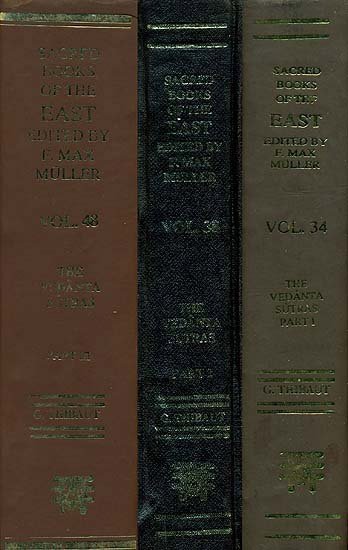Brahma Sutras (Ramanuja)
by George Thibaut | 1904 | 275,953 words | ISBN-10: 8120801350 | ISBN-13: 9788120801356
The English translation of the Brahma Sutras (also, Vedanta Sutras) with commentary by Ramanuja (known as the Sri Bhasya). The Brahmasutra expounds the essential philosophy of the Upanishads which, primarily revolving around the knowledge of Brahman and Atman, represents the foundation of Vedanta. Ramanjua’s interpretation of these sutras from a V...
Sutra 3.3.32
32. There is no restriction (since) all (have to go on that path). (Thus) there is non-contradiction of sacred text and Smṛti.
The question here is whether Brahman is to be reached on the path of the gods by those only who take their stand on those meditations which, like the Upakośala-vidyā, describe that path, or by all who practise any of the meditations on Brahman. The Pūrvapakshin holds the former view, since there is no proof to show that in other vidyās the going on that path is not mentioned, and since those other vidyās-such as the texts 'and those who in the forest meditate on faith and austerities,'and' those who in the forest worship faith, the True' (Ch. Up. V, 10, 1; Bṛ. Up. VI, 2, 15)—suggest to the mind the idea of the knowledge of Brahman. This the Sūtra negatives. There is no restriction to that limited class of devotees, since all who carry on meditations have to go on that path. For on this latter assumption only text and inference, i.e. scripture and authoritative tradition, are not contradicted. As to scripture, the Chāndogya and the Vājasaneyaka alike, in the Pañcāgni-vidyā, declare that all those who practise meditation go on that path. In the Vājasaneyaka the words 'who know this' refer to those who practise the meditation on the five fires, while the following words 'those who in the forest meditate on faith and the True' refer to those who meditate on Brahman; and the text then goes on to say that all those devotees go to Brahman, on the path of the gods. Texts such as 'the True, knowledge, infinite is Brahman,' and 'the True must be enquired into,' prove that the term 'the True' denotes Brahman; and as in the Chāndogya the term 'tapas ' occurs in the corresponding place, we conclude that both these terms, viz. the True and tapas, denote nothing else but Brahman. Meditation on Brahman, preceded by faith, is mentioned elsewhere also; in the text which begins 'The True must be enquired into' we read further on 'Faith must be enquired into' (Kh. Up. VII, 18, 16; 19). Smṛti also declares that all those who know Brahman proceed on the path of the gods, 'Fire, the light, the day, the bright fortnight, the six months of the sun’s northern progress—proceeding by that road those who know Brahman go to Brahman' (Bha. Gī. VIII, 24). And there are many other Śruti and Smṛti passages of this kind. The conclusion therefore is that the Upakośalavidyā and similar texts merely refer to that going of the soul which is common to all vidyās.—Here terminates the adhikaraṇa of 'non-restriction.'
